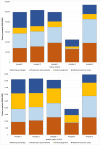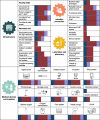Process and costs for readiness to safely implement immediate kangaroo mother care: a mixed methods evaluation from the OMWaNA trial at five hospitals in Uganda
- PMID: 37301974
- PMCID: PMC10257176
- DOI: 10.1186/s12913-023-09624-z
Process and costs for readiness to safely implement immediate kangaroo mother care: a mixed methods evaluation from the OMWaNA trial at five hospitals in Uganda
Abstract
Background: Preterm birth complications result in > 1 million child deaths annually, mostly in low- and middle-income countries. A World Health Organisation (WHO)-led trial in hospitals with intensive care reported reduced mortality within 28 days among newborns weighing 1000-1799 g who received immediate kangaroo mother care (iKMC) compared to those who received standard care. Evidence is needed regarding the process and costs of implementing iKMC, particularly in non-intensive care settings.
Methods: We describe actions undertaken to implement iKMC, estimate financial and economic costs of essential resources and infrastructure improvements, and assess readiness for newborn care after these improvements at five Ugandan hospitals participating in the OMWaNA trial. We estimated costs from a health service provider perspective and explored cost drivers and cost variation across hospitals. We assessed readiness to deliver small and sick newborn care (WHO level-2) using a tool developed by Newborn Essential Solutions and Technologies and the United Nations Children's Fund.
Results: Following the addition of space to accommodate beds for iKMC, floor space in the neonatal units ranged from 58 m2 to 212 m2. Costs of improvements were lowest at the national referral hospital (financial: $31,354; economic: $45,051; 2020 USD) and varied across the four smaller hospitals (financial: $68,330-$95,796; economic: $99,430-$113,881). In a standardised 20-bed neonatal unit offering a level of care comparable to the four smaller hospitals, the total financial cost could be in the range of $70,000 to $80,000 if an existing space could be repurposed or remodelled, or $95,000 if a new unit needed to be constructed. Even after improvements, the facility assessments demonstrated broad variability in laboratory and pharmacy capacity as well as the availability of essential equipment and supplies.
Conclusions: These five Ugandan hospitals required substantial resource inputs to allow safe implementation of iKMC. Before widespread scale-up of iKMC, the affordability and efficiency of this investment must be assessed, considering variation in costs across hospitals and levels of care. These findings should help inform planning and budgeting as well as decisions about if, where, and how to implement iKMC, particularly in settings where space, devices, and specialised staff for newborn care are unavailable.
Trial registration: ClinicalTrials.gov, NCT02811432 . Registered: 23 June 2016.
Keywords: Implementation; Intervention costs; Kangaroo mother care; Low birthweight; Newborn care; Preterm; Service readiness.
© 2023. The Author(s).
Conflict of interest statement
The authors declare that they have no competing interests.
Figures




References
-
- Blencowe H, Cousens S, Oestergaard M, Chou D, Moller A, Narwal R, et al. National, regional, and worldwide estimates of preterm birth rates in the year 2010 with time trends since 1990 for selected countries: a systematic analysis and implications. Lancet. 2012;379:2162–2172. doi: 10.1016/S0140-6736(12)60820-4. - DOI - PubMed
-
- GBD 2017 DALYs and HALE Collaborators Global, regional, and national disability-adjusted life-years (DALYs) for 359 diseases and injuries and healthy life expectancy (HALE) for 195 countries and territories, 1990 – 2017: a systematic analysis for the Global burden of disease study. Lancet. 2018;392:1859–922. doi: 10.1016/S0140-6736(18)32335-3. - DOI - PMC - PubMed
-
- Abbafati C, Machado DB, Cislaghi B, Salman OM, Karanikolos M, McKee M, et al. Global burden of 369 diseases and injuries in 204 countries and territories, 1990–2019: a systematic analysis for the global burden of disease study 2019. Lancet. 2020;396:1204–1222. doi: 10.1016/S0140-6736(20)30925-9. - DOI - PMC - PubMed
Publication types
MeSH terms
Associated data
Grants and funding
LinkOut - more resources
Full Text Sources
Medical

